Sarah Ash's Blog, page 2
July 8, 2023
Tackling The Guinevere Problem in The Cleaving – Juliet E. McKenna
This depiction of Queen Guinevere by John Collier, painted around 1897, sums up the challenge this particular character poses for anyone re-examining the Arthurian mythos from a female-centred or feminist point of view. This Guinevere is as passive as she is beautiful. An ideal who keeps her mouth shut. She’s not even holding the reins of her own horse as she’s led along as Queen of the May, obediently using hawthorn sprays to frame her lovely face.
This painting specifically refers to Tennyson’s version of Guinevere in his ‘Idylls of the King’. When the court returns from this Maying procession, Sir Lancelot sees sneaky Mordred spying on Guinevere and her maids. Lancelot smacks Mordred about a bit and sends him on his way. When he tells Guinevere though, she is seized with such uncontrollable desire for Lancelot that she runs away to a convent. The sin, Tennyson repeatedly tells us, is the queen’s. She’s the wife. Lancelot is single. By running away, she makes things worse. Conflict between Arthur and Lancelot follows. Mordred usurps the throne and everything is Guinevere’s fault. Not that she does anything about it, sitting in her cloister and lamenting.
This version of Guinevere is a prime example of the uses Victorian writers and artists made of the Arthurian mythos. Portraying Arthur as the noble and kingly ideal promoted loyalty to the crown, and not-so-incidentally gave Queen Victoria’s rule a spurious gloss of ancient, revered tradition. This worked so well that many modern readers are unaware how insecure Victoria’s seat on her throne was at times. Lancelot and Guinevere’s adultery is an undeniable element of the story so Tennyson cannot ignore it, but if Arthur’s the ideal king, he cannot be at fault. Lancelot is the epitome of chivalry, so he can’t be at fault either. Guinevere must be in the wrong, playing into every patriarchal prejudice about weak-willed women that Victorian society sought to uphold, in an era where real-life women were demanding the right to think for themselves, to ride bicycles, to wear rational dress, and to vote.
What’s a 21st century writer supposed to do with that level of misogyny?! It’s no wonder some authors offer wholesale rewrites of Guinevere’s character, especially in those versions of the myth looking for a plausible ‘historical’ Arthur. Keira Knightley as kickass Celtic warrior maiden in the 2004 movie King Arthur leaps to mind. And that’s fine, if that’s the story the author wants to tell. But that’s not what I set out to do in The Cleaving. I wanted to look at the core familiar story, and to interrogate that tradition from a different perspective. A female perspective. What am I supposed to do with a witless, weeping Guinevere who’s so wet you could wring her out?
Unless … her story offers an opportunity to highlight a facet of feminism that can be too often overlooked. Epic fantasy fiction has challenged the stereotype of the damsel in distress for decades, but the alternative most frequently presented is the kickass warrior maiden. She takes on the boys at their own games, and she wins. I’ve seen such heroines labelled ‘faux-male’. They have their place, don’t get me wrong, but they can unintentionally imply masculine strengths and virtues are superior. Where does that leave women without the strength or the desire for confrontation? Where does that leave the so-called ‘soft’ skills of negotiation, organisation, communication and cooperation, which are so often cited as women’s strengths?
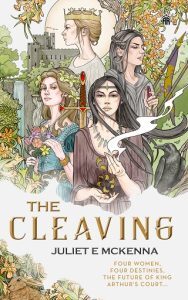
This was the key to following Guinevere’s traditional narrative in the story I wanted to tell. This Guinevere is content to enter her arranged marriage. She strives to be a good wife. She obeys her husband, rarely speaks unless spoken to, and does her duty to look decorative without question. She uses those soft skills to unobtrusively support the king. Playing by these rules doesn’t save her though, when she is blamed for things entirely beyond her control. When this provokes her into crossing a line, the patriarchal double standard means there’s no way back for her. The more I worked on this book, the more I realised her story was an essential counterpoint to Morgana’s strong-willed independence.
These elements are already there in the classic Arthurian tradition. Drawing them out and challenging them from a 21st century female perspective gives a very different Guinevere as a once and future queen.

Juliet E McKenna is a British fantasy author living in the Cotswolds, UK. She has loved history, myth and other worlds since she first learned to read. Her debut epic fantasy novel, The Thief’s Gamble, began The Tales of Einarinn in 1999, followed by The Aldabreshin Compass series, The Chronicles of the Lescari Revolution, and The Hadrumal Crisis trilogy. In 2018 The Green Man’s Heir began an ongoing contemporary fantasy series rooted in British folklore. The sixth novel will be published later this year. Her wide-ranging shorter fiction includes dark fantasy, steampunk and SF. The Cleaving, from Angry Robot, is her female-centered retelling of Arthurian myth.
Please Feel Free to Share:





July 7, 2023
Juliet E. McKenna Will Be Offering Some Fascinating Insights On Her Arthurian Novel: The Cleaving!
Are you a fan of Arthurian fiction? If so, The Cleaving, Juliet E. McKenna’s new novel, could be your next read! To discover more about the inspiration that led to its creation, drop by the Guest Blog here on July 8th to read Juliet’s insightful article.
Please Feel Free to Share:





January 23, 2023
Where It All Began: Susie Williamson looks back to the genesis of her fantasy series Blood Gift Chronicles
Thank you for inviting me back to guest on your blog, Sarah. It was a pleasure the first time around, introducing my fantasy series, Blood Gift Chronicles, which begins with Return of the Mantra, followed by The Warder. Since then it has been an exciting time, including both books winning Firebird Book Awards in 2021, in the LGBTQ+ fiction category and the YA fiction category. The books were many years in the making, and so it was wonderful to receive award status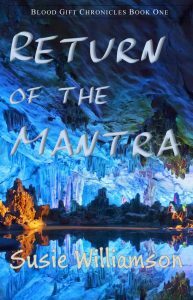
Thinking about this blog got me thinking back to where it all began. I first started working on Return of the Mantra back in 2006, after returning to the UK from four years working in Africa: the Sudan, followed by South Africa. Those experiences affected me greatly, and inspired me to rekindle a love of writing, which resulted in a novel planned on post-it notes stuck to my door.
The world in Return of the Mantra is entirely fictional, a land of contrasts loosely inspired by African deserts, sweeping grasslands and lush bushland. Touching on themes of climate change, the consequences of man’s interference with nature is felt, leaving a society torn: common beliefs of a once nomadic people are reduced to a dying mythology, while exploitation flourishes. The main character, a young woman, Suni, is faced with the big question: can her world be restored? It’s a fight for justice, and her own identity, a reminder that to change the world, we must first know ourselves. There are so many aspects of Suni’s character that I enjoy, including a romantic relationship she develops with another woman as part of her backstory. And I love that this relationship thrives and grows throughout the series.
The Warder picks the story up ten years on from the first book, and introduces a new land. I had a lot of fun with the archipelago of islands in the far western reaches, incorporating art into the fabric of the world. (I’m also an artist.) We are taken deeper into this unfolding world by a magic system inextricably linked to the mystery of dragons. I didn’t start out with the intention of writing dragons, and yet I was drawn to them, perhaps for their awe-inspiring other-worldly magic, their ultimate strength and lesson in humility, the fact that there are things bigger than us, outside of our control. Although rather than the idea of going up against a dragon, trying to beat a dragon, the story develops into becoming a dragon, what that reflects in us, storylines analogous to loss, love, loyalty, grief and empowerment. The idea of dragons coincides with a kind of melancholy and themes around extinction – extinction of magic, the fantastical, and creature extinction, which fits with themes in the books.
All of this and more is why I love reading and writing in the fantasy genre, for the colour and the ultimate licence of creativity.
My current work in progress is Book 3, an origin story giving closure to the big mysteries, while introducing two new characters, a new landscape, and a timeslip plot. We are interconnected, the past informs the present, the future is ours for the taking. I think fondly of my characters that I have lived with for so long, as I think of them tackling these life lessons.
If there’s time, I’ll leave you with an extract from The Warder, when we first meet Suni again, ten years after where we left her in the first book. A woman with a gift…
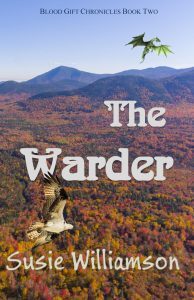
The Warder
“MY MOTHER HAD BEEN A dreamwalker, a gift passed from mother to daughter. We were separated for years before she died, but she had always been able to reach me in my dreams. It was only after she died, ten years ago, that I realised the gift had found its way to me.
I see the mists of Serafay at the edge of my dreams, mists only the dead or a dreamwalker can know. How to navigate the mists is still a mystery even to me; it just is. Sometimes I think the destination lies rooted in desire. My mother had missed me, worried for me, a longing that had led her to me. My own nightly ventures took me to the dreams of my young friend, Wanda; a gifted boy I had known since he was an infant. Ours was a bond formed during an extraordinary journey we had once shared.
Much had changed since then, and the distance between us meant I couldn’t visit often. A boy gifted to speak the tongues of animals, he lived among wildlife in the valley beyond the mountains, while I had returned to my coastal hometown. I thought of him often, worried about him. I was aware that his relationship with Ntombi, my old friend, was not as it should be. I was thankful for my gift, reassured by my visits into his dreams.
ONE NIGHT I CLOSED MY eyes and drifted from the waking world, descending into sleep. Random colours and images of everyday life came and went, but I drifted on through until the colours drained to grey, and I was standing before the wall of mist. I stepped in, abandoning caution, and surrendered to my gift.
In the thick grey haze, the air was still and cool. I walked blind, deeper into the mist where ghosts crossed my path. They appeared oblivious to me, sometimes walking straight through me, leaving the cold of their presence lingering on my skin. Whilst my mother was at peace, ghosts aimlessly wandering Serafay had mournful, despairing eyes.
I felt a change in the air; a slight breeze brushed against my hand. I held out my hands, finding the direction, and turned to walk into the breeze. It was always the same, the mist showing me the way. The breeze grew stronger the further I went into the tunnel of moving air that was hidden from the dead. Among the swirling tones of grey, a window of colour appeared up ahead. I walked towards it, unsure of where it would lead. The only certainty was the dreamer; it was always Wanda I came to when I walked out of Serafay.
I stepped out of Serafay to find myself in Juna’s cave. Wanda was there, his back to me, sitting with legs dangling over the overhanging shelf, head cocked as he looked out over the grasslands. I stepped around the burnt-out fire and went to him. The sun was shining down as I stood next to him on the ledge, but the cold of Serafay lingered.
I crouched down and looked at his face. He never saw or heard me in the dream world. Sometimes I’d see him appear unresponsive to anything as he gazed intensely into space. This time was different; only the whites of his eyes were showing. I put a hand on his arm, reassured by the warmth of his body that felt like a shock against the cold of mine, and looked out across the landscape. Where are you? Startled by a shrill call overhead, I glimpsed a circling hawk, before Serafay came to claim me.”
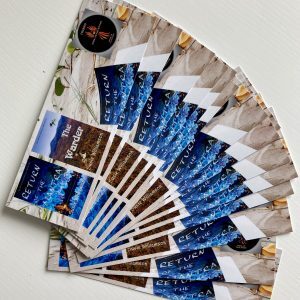
Author Bio:
Originally from Yorkshire, Susie started out as a science teacher. She went on to spend four years living and working out in Africa when she was in her twenties, before returning to the UK. She is the author of the award-winning fantasy series, Blood Gift Chronicles, published by Stairwell Books, and is currently working on Book 3 of the series. Susie is also an artist, a published poet, and a regular spoken word performer in her hometown of Exeter.
Links:
Website: http://susiewilliamson.blog
Published by Stairwell Books: http://www.stairwellbooks.co.uk/product/the-warder/
Facebook: https://www.facebook.com/SusieWilliamsonAuthor
Twitter: https://twitter.com/SJW_writer
Instagram: https://www.instagram.com/sjw_creatives/
Firebird book Awards: https://www.speakuptalkradio.com/author-susie-williamson/
Please Feel Free to Share:





January 21, 2023
The Guest Blog – Susie Williamson is the First Author Visitor of 2023!
SFF fiction often starts from a seed, a kernel of an idea and then grows into something rich and strange. That seed might be a snatch of a song, a glimpsed landscape, a dream, an unexpected encounter – it will vary from writer to writer but from such small beginnings, engrossing and captivating stories evolve!
I’m delighted to welcome back Susie Williamson to the Guest Blog on January 23rd as she looks back to the genesis of her fantasy series Blood Gift Chronicles. Join her to learn more about her novels and to read an extract from The Warder!
Please Feel Free to Share:





November 17, 2022
In Cases of Murder – Jan Edwards introduces her latest crime novel
One of the questions I always dread from readers is “where do you find your inspiration?”. More often than not, I simply don’t know but with In Cases of Murder, the latest of the Bunch Courtney Investigations, I can pinpoint its birth quite precisely.
Commissions for anthologies are often simpler because you are usually given a prompt. I may seek a seed from folk tales for horror fiction or newspaper reports for crime. Novels of 85k need more fuel than an 4k short and quite often there is no one single piece of fact (or fiction) that sets the wheels churning.
With the Bunch Courtney Investigations series, the basic choices are already in time and place so one might be tempted to assume that would make plots simpler to devise. Not a bit of it! I may have Rose ‘Bunch’ Courtney quite firmly established in the fictional Sussex village of Wyncombe, solving crimes in the dark days of WW2, but finding her consecutive crimes to tackle that are substantially different from the previous plots, and which won’t turn Wyncombe into another Midsummer or St Mary Mead, is often far trickier.
So what was it that spawned In Cases of Murder? In the 1934 two gruesome discoveries were made in Brighton, Sussex (UK) that involved bodies being concealed in suitcase/trunks. These two crimes were committed in the same year but unconnected so far as police were aware.
Violette Kaye was hidden in a trunk by her lover Tony Mancini, who claimed he had discovered her already dead and hidden her remains because he feared his criminal record would be held against him. He was found not guilty, though he confessed some forty years later to killing Violette in self-defence after she had attacked him with a coal hammer.
The other murder – and to me the more interesting crime from a fiction angle – was dubbed ‘The Girl with the Pretty Feet’ or ‘Pretty Feet’ murder. The torso of a young woman was found in a plywood trunk in Brighton Station’s left luggage, while her legs and feet (which gave rise to the name) were found in a suitcase some sixty miles north, at King’s Cross Station in London. Her head and arms were never found, nor was anyone ever arrested for her murder.
I found the possible scenarios for Pretty Feet’s demise seemingly endless – and a perfect starting point not just for the plot but also the title for In Cases of Murder. How the rest of the plot came to me is far more of a mystery!
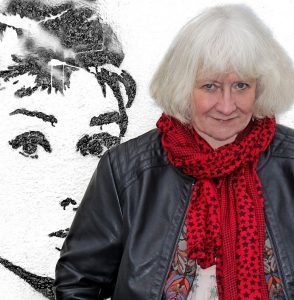
Jan Edwards is a Sussex-born writer now living in the West Midlands with her husband and obligatory cats. She was a Master Locksmith for 20 years but also tried her hand at bookselling, microfiche photography, livery stable work, motorcycle sales and market gardening. She is a practising Reiki Master. She won a Winchester Slim Volume prize, and her short fiction can be found in crime, horror and fantasy anthologies in UK, US and Europe, including The Mammoth Book of Dracula and The Mammoth Book of Moriarty. Jan edits anthologies for The Alchemy Press and Fox Spirit Press and has written for Dr Who spinoffs with Reel Time Pictures.
ISBN-13 : 978-19162865351st December 2022 Kindle and paper editions
Amazon UK Amazon.com Hive Waterstones
Amazon UK Kindle Amazon.com Kindle
Please Feel Free to Share:





November 16, 2022
Jan Edwards Visits the Guest Blog!
I’m very pleased to welcome Jan Edwards back to the Guest Blog tomorrow to introduce the latest novel in her Bunch Courtney Investigations series: In Cases of Murder.
Please Feel Free to Share:





May 2, 2022
Awakening – Lucy A. McLaren introduces her debut YA dark fantasy novel
In the Kingdom of Septima, the authoritarian Commune hunts down children born with ancient powers in order to strengthen their hold over King and country. Evelyn Folksman must protect brother and sister, Raif and Rose, from the Commune’s soldiers… but can she keep them at bay when 6-year-old Rose reveals incredible and deadly powers?
I’m Lucy A. McLaren, fantasy geek, author and counsellor. Awakening is my debut novel and the first in The Commune’s Curse trilogy. It’s a YA dark fantasy that explores what it means to be “good” and “bad” and includes realistic mental health issues such as trauma and grief. Release day is 1st May 2022 from Santa Fe Writers Project (SFWP).
The multi-POV story is set in the Kingdom of Septima, where a ruthless cult rules in all but name, hunting down children born with ancient powers in an attempt to strengthen their hold over the kingdom. Evelyn, 18, finds herself on the run from soldiers of the Commune as she tries to protect two children, Raif and Rose. It soon becomes all too clear how much danger they are in when young Rose reveals incredible and deadly powers. Commander Jonah Sulemon doggedly pursues them under the orders of the man he loves, Commune agent Lord Torrant, and Evelyn is forced to accept the uncertain safety offered by a rebel group or risk capture—or worse—at the hands of the Commune.
I’ve loved fantasy stories since I was young and really enjoyed writing my own. When I was training to be a counsellor four years ago, I decided to finally push myself to write a full novel. At the time, I had started playing D&D and creating my character Evelyn’s backstory really sparked my creative urges. I used that as a way to start writing more (Evelyn being arguably the main POV in Awakening).
I’m very much inspired in my writing by my work as a counsellor. I’ve worked with teenagers and young people and have been able to see common experiences within such age groups. I’ve used those, along with personal experiences, counselling theory and mental health theory to create what I hope are realistic, flawed characters. Each of the main POVs are trying to work through past experiences, to understand what is happening to them, and to establish who they can truly trust. Despite not being on the same sides, I think the commonality of certain human experiences does link them in a lot of ways. I admire writers liked Robin Hobb and Joe Abercrombie, especially in terms of how they write their characters, and this is what I’ve aspired to in Awakening—characters who feel like they could be real people. I can’t wait for you to meet Evelyn, Raif, Hector and Commander Sulemon.
Read a short extract from Awakening:
The animal cowered, tail tucked between its legs and body hunched. It was filthy, half-starved, and pitiful. He fiddled with his shirt sleeves, wishing he could cover the cuts and bruises mottling his pale skin, hoping he didn’t appear to the Grand Magister as pathetic as this creature did to him. The boy reached for the dog, hand hovering above it. The fear radiating from its ragged form was palpable. It knows. He drew his hand back, trying to steady himself. The dog sensed his hesitation; taking advantage of the boy’s uncertainty, it growled and snapped at him, teeth bared. The boy jerked back, thudding onto the floor. You idiot. His cheeks flushed and he glanced up at the Grand Magister, finding neither sympathy nor reassurance—only that constant, unflinching stare.
In the silence, one of the figures sitting beside the Grand Magister stood and approached him. The rest of the room still, their footsteps echoed. They leant down and offered a hand. The boy thought he saw a woman’s face beneath the dark hood, a gentle smile and sad eyes. He thought of his brother then—a time when he’d fallen amongst the jutting roots of Taskan Forest, when Ythan picked him up and dusted him off. “I’m here, little brother.”
You’re not here now.
Author bio
Lucy is a fantasy author and professional counsellor, passionate about writing stories that include a realistic representation and exploration of mental health issues. Her debut novel, Awakening: The Commune’s Curse Book 1, releases from Santa Fe Writers Project on 1st May 2022.
Website and social media
Lucy A. McLaren  – Author website and blog (wordpress.com)
– Author website and blog (wordpress.com)
Twitter – @lucyamclaren
Instagram – lucy_a_mclaren
Facebook – Lucy A. McLaren Author (page)
Please Feel Free to Share:





May 1, 2022
Lucy A. McLaren Visits the Guest Blog on May 2nd
Happy Book Birthday to Lucy A. McLaren today – May 1st – publication day! Drop by the Guest Blog tomorrow to read more about Awakening – her debut novel!
Please Feel Free to Share:





January 3, 2022
How to Avoid Committing Trilogy Three Times In a Row: Jacey Bedford introduces her new fantasy novel
The Amber Crown, my seventh book, is due out from DAW on 11th January. I’d like to thank Sarah for giving me space on her blog for me to shout about it. DAW is giving me an online launch on publication day. Join my mailing list to get the exact time as soon as I know it myself. The Amber Crown is being published on both sides of the Atlantic. My other six books are published in North America only, so they are only available in the UK as American imports, which means you can only get them as physical books over here, not electronic ones. The Amber Crown, however, is a trade paperback (the large format one) available in print or on Kindle on both sides of the Atlantic.
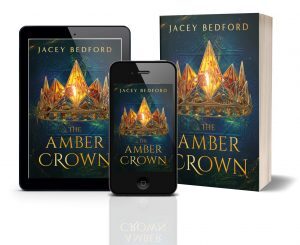
The Amber Crown is a standalone. After writing two trilogies, I fancied writing a story which could be wrapped up in just one book.
When I started writing the first Psi-Tech book (Empire of Dust) and the first Rowankind one (Winterwood) I never actually thought that I’d end up with two trilogies. At that stage I was unpublished and writing on spec. I’d made the rookie mistake several years earlier of writing the first two books in a trilogy. My (then) agent couldn’t sell my first one, and therefore she couldn’t even submit the second one, so I effectively wasted two or three years of my writing life. After that I decided to write standalones with the potential to become trilogies, so when my lovely editor bought Winterwood way back in 2013, she asked that wonderful question, ‘What else have you got?’
I sent her Empire of Dust which became the first Psi-Tech book and actually ended up being published before Winterwood because there was a science fiction-shaped place in the publication schedule. My editor liked it enough to order a sequel (Crossways) and then a third one (Nimbus). The same thing happened with the Rowankind books (Winterwood, Silverwolf and Rowankind) so I ended up with two trilogies.
Without really intending to, I committed trilogy twice.
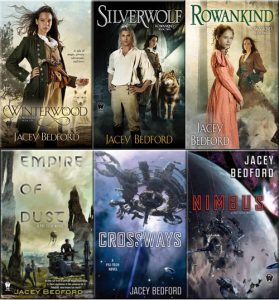
The Amber Crown always told me that it wanted to be a standalone. (What? Your books don’t talk to you?) My trilogies have single book plots (no cliffhanger endings) plus an overarching problem which takes three books to resolve. There’s a single problem in Amber, and it’s resolved by the end. I have no intention of writing The Further Adventures of Valdas, Lind, and Mirza, much as I liked spending time with the characters while I was writing.
The big problem is that the assassination of a (good) king plunges the Baltic country of Zavonia into chaos. Valdas, the dead king’s bodyguard, has not only failed in his duty, but he’s on the run accused of the murder. Mirza, witch-healer of a Landstrider band, is given a task from beyond the grave by the dead king. And Lind, the actual assassin, is beginning to think it was a bad idea to take on the job, especially since he believes there’s magic at work. It’s up to these three flawed individuals to discover who ordered the assassination and to set things right before Zavonia ends up fighting a costly war on two fronts.

Jacey Bedford is a British writer of science fiction and historical fantasy. She is published by DAW in the USA. Her Psi-Tech and Rowankind trilogies are out now. Her new book, The Amber Crown, is out on 11th January 2022 and is available from Amazon. Her short stories have appeared in anthologies and magazines on both sides of the Atlantic, and have been translated into Estonian, Galician, Catalan and Polish. In another life she was a singer with vocal trio, Artisan, and once sang live on BBC Radio4 accompanied by the Doctor (Who?) playing spoons.
Website/mailing list: http://www.jaceybedford.co.ukBlog: jaceybedford.wordpress.comFacebook: https://www.facebook.com/jacey.bedford.writerTwitter: @jaceybedfordArtisan: http://artisan-harmony.com
Please Feel Free to Share:






January 2, 2022
Jacey Bedford Visits the Guest Blog on January 3rd!
I’m thrilled to welcome Jacey Bedford to the Guest Blog tomorrow – the first guest writer of 2022! – to introduce her new novel: The Amber Crown.
Please Feel Free to Share:








